Pigs and sheep as lawnmowers. Could they help NY achieve green energy goals?
The pigs were, well, being pigs, hogging the grain Caleb Scott dumped from a bucket while sheep spy the feast from a safe distance, waiting for a turn that never comes.
A few with the courage to venture near are angrily snorted away. When the feed is gone, a few grunting pigs tuck their snouts inside an empty bucket, trying for the last morsel. And the sheep get back to grazing.
Another day on the farm.
Make that a solar farm, where pigs and sheep are learning to co-exist peacefully (mostly), while grazing fields of fescue and wildflower beneath 30 acres of 18,000 solar panels in Lansing, north of Ithaca.
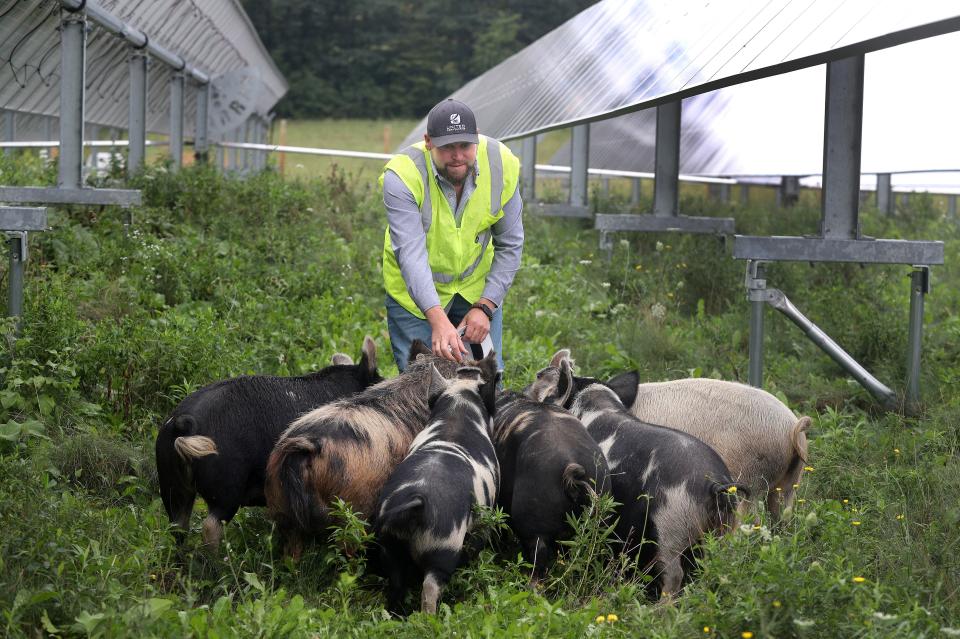
It’s a unique experiment designed, in part, to quell concerns that vast swaths of useful upstate farmland are being lost in the state’s rush to add renewable energy by having pigs and sheep do the work of lawn mowers and weed whackers.
Eagles: Years after saving the bald eagle, NY backs wind farm projects that could kill 82 of them
Solar and farming in NY: A match made in the grass?
Consider that to achieve its goal of 60 gigawatts of solar energy by 2050, New York will need about 180 million solar panels.
Most of those will be concentrated on large-scale developments planned for upstate, covering more than a hundred thousand acres of cheap and abundant farmland. To make room, wildlife habitats will be disrupted and fields of trees will be clear cut.
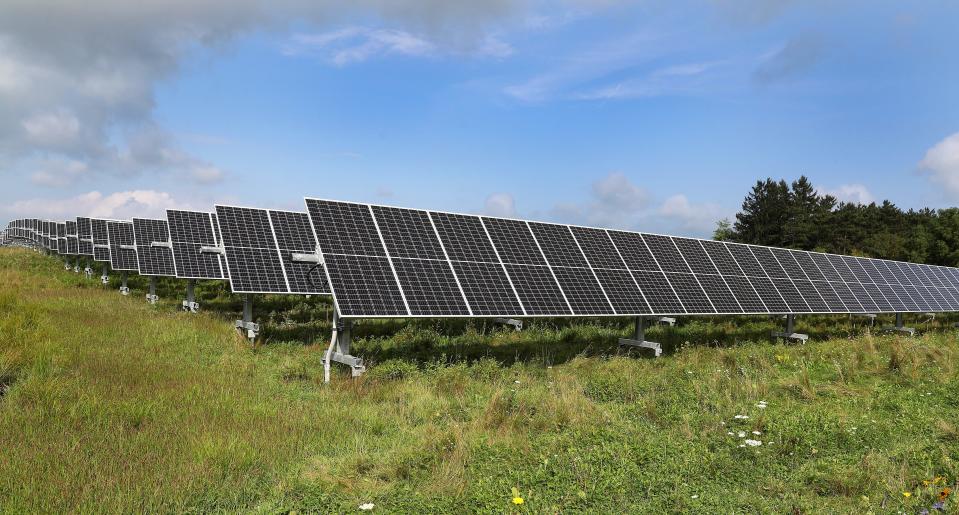
Towns are pushing back with legal challenges that have stalled projects, so many that the state created an agency to streamline the approval process. Residents are questioning why upstate land is being sacrificed when the region already taps into enough clean energy — nuclear, hydropower, solar and wind — to serve its needs.
What’s produced upstate will be sent down to help New York City to help reverse its near-total reliance on fossil fuels.
Upstate lawmakers are introducing measures to spare agricultural land while encouraging solar developers to stick their panels on rooftops and brownfields instead.
Farmers: Solar developers approached two NY farmers. Their choices reveal an industry in crisis
Into all this steps Scott, a third-generation farmer from the town of Caroline who arrived at this moment after a maddening attempt to mow a field beneath solar panels more than a decade ago.
He realized then that, with a little work, he could make a business out of merging two seemingly disconnected ventures — one ancient, one new — by fattening up his sheep on the nutrient-heavy buffet of plants that grow on solar farms.
Scott’s family had to give up its dairy farm business in the 1980’s when hard times hit. Finding land and opportunities has not been easy. Solar grazing, or "agrivoltaics" as it has been dubbed, has filled the gap.
“When I look out over this sea of blue, I think what an amazing way for our country to maximize our resources,” Scott said one day in August, surrounded by pigs and sheep and solar panels in a field along Jerry Smith Road marked by an American flag. “We’re ensuring our grid for our future generations. We’re ensuring farming for our future generations. We’re feeding our animals on a power plant. Try doing that on a coal plant.”
New York has seven years to achieve a goal of 70% reliance on renewable power for its energy needs. Could pigs and sheep be the answer?
Maybe not. But they could chew their way through a few obstacles along the way while reviving a sheep market in New York.
Whales: Surge in whale deaths in NY waters has scientists scrambling for solutions
'My sheep would do a better job'
Rocks were banging off solar panels. A lawn mower was getting stuck in the mud when it wasn’t hitting tree stumps.
This was 12 years ago when Scott was hired to mow the grass at a solar farm on Cornell University land.
He’d had it.
“My sheep would do a lot better job on this,” Scott told the developer.
The idea went nowhere until folks at Cornell got wind of it.
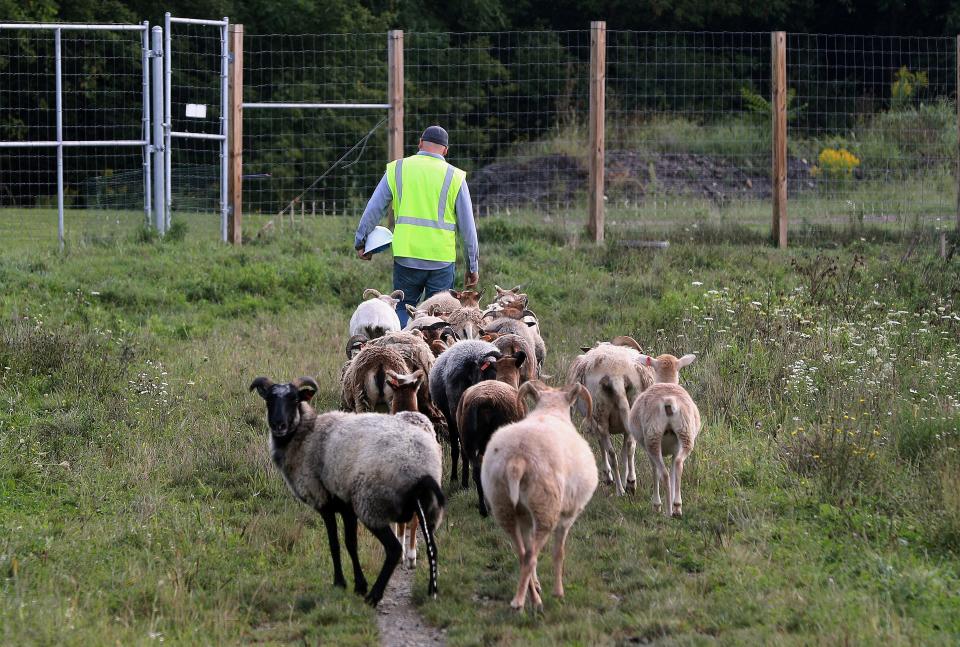
Today, Cornell has three solar grazing farms on its campuses in Ithaca. The biggest of them is the 54-acre Cascadilla Community Solar Farm.
There, students from Cornell’s sheep and plant science programs are researching the economics of solar grazing — what’s cheaper? Mowing or grazing? — as well as questions like just how many sheep it takes to graze an acre (the answer? three).
Most of the research into solar grazing has focused on sheep, while pigs are new to the game. The Lansing farm, where Scott is trying out breeds less likely to do pig things like root into the ground, is the first to deploy pigs and sheep.
Cornell breeds about 300 sheep on its farms, many of which will go on to work on solar farms.
Niko Kochendoerfer, a post-doctoral animal science researcher at Cornell, has been studying the issue for the past six years.
A 2021 study she co-authored with the late Cornell professor Michael Tonney showed solar grazing in New York surged from nearly 80 acres grazed in 2017 to 900 acres four years later. Current estimates peg the total around 2,000 acres.
Not a week goes by without a few inquiries from farmers or developers.
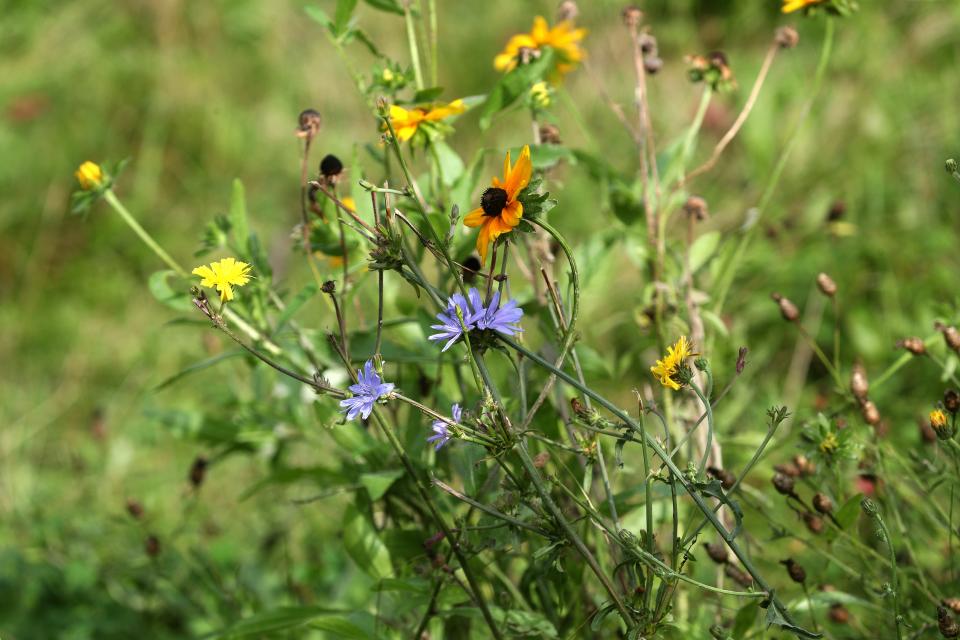
“There’s so many of them going in, I get weekly requests from developers saying, ‘We’d like to graze this site, how do I go about finding a shepherd?,” Kochendoerfer said. “Or a sheep farmer saying, ‘Hey, there’s this development going on 10 miles down the road, how do I go about grazing this?’ There’s a lot of buzz around it.”
Organizations like the American Solar Grazing Association and Scott’s United Agrivoltaics pair farmers with developers.
New York counted 2,113 sheep farmers in 2021. Of those, 646 have flocks of between 25 and 299 sheep.
It can be expensive — and frustrating — to clear a site of weeds and vegetation that grows up into solar panels. Sheep present an alternative.
“It’s pretty cost intensive to fix that because it’s often manual labor, literally with weed whackers, and that goes away completely with the sheep, because they like the shade,” she said.
And solar farms have fences that keep predators away.
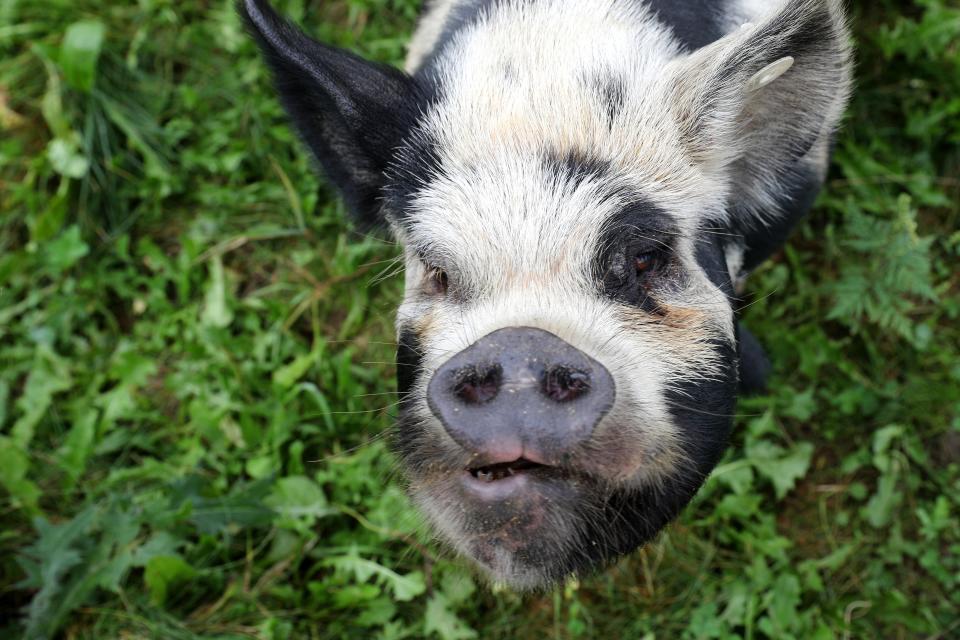
Pigs are new to the game
Nearly all of New York’s solar grazing is done on community solar farms of 10 to 30 acres, developments funded by nearby customers who get a credit on their utility bills for funding renewable energy.
The most prolific has been Boston-based Nexamp, which leases the property in Lansing for a solar farm that produces 6.8 megawatts of energy, enough to power 1,100 homes. It's been generating electricity for New York State Energy and Gas (NYSEG) since November 2020.
The company now has 18 solar grazing sites in New York. Of its 300 solar projects across the U.S, 40 use solar grazing.
“Our mission is taking care of the environment and so coming in and doing this and then running -gas-powered lawn mowers and weed whackers four times a year doesn’t necessarily contribute to that,” said Nexamp’s Keith Hevenor. “This option to us is a no brainer.”
Peakers: Fossil fuel-burning plants cover power gaps. But they're foiling NY's clean energy plans.
Scott gets paid to bring in his sheep and pigs and the owner of the property gets paid to lease the land to Nexamp. The 2021 Cornell study determined that sheep farmers were making between $300 and $500 per acre of a solar site per year.
Scott breeds the pigs at his farm in Caroline and trucks them into Lansing.
For the job, he’s selected a mix of Idaho pasture pigs and Kunekune — Maori for fat and round — whose shorter snouts make it less likely they’ll dig into the ground and destabilize the solar panels.
The land is leased from Wayne Straw, a retired truck driver who’s owned the property since 1973 and has rented it out to other farmers in the past.
He enjoys his new neighbors, who scurry to the fence when he arrives with a bucket of feed. “The sheep stand back there watching the pigs,” he says. “When the pigs leave, the sheep come back.”
The feed is a treat, like ice cream on Sunday. Most days they are feeding off the plants that are growing beneath the panels, a balanced diet calibrated by Scott.
The question is whether the small-scale grazing taking place now in New York could work on larger sites planned for upstate that would cover hundreds, if not thousands, of acres.
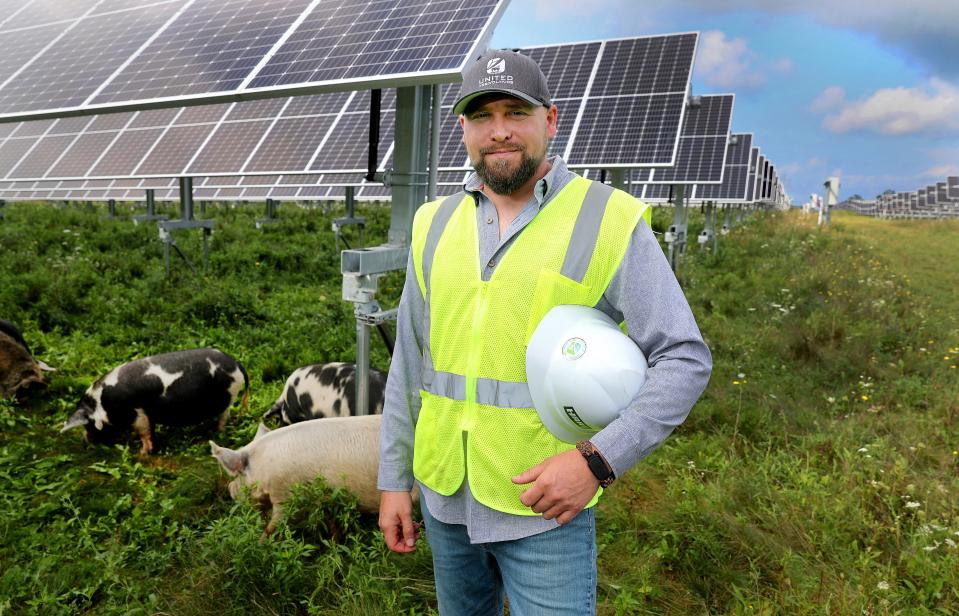
Could NY scale up its solar grazing operations?
Texas and California have solar grazing sites of 5,000 acres or more.
But to make the leap, the state would need to add another 206,000 sheep to graze the 130,000 acres of utility-scale developments planned for New York in the next seven years, the Cornell study found.
That would be more than double the state’s roughly 80,000 sheep and lamb as of January, a sliver of the 5 million across the U.S., according to U.S. Department of Agriculture figures. New York ranks 19th among states in total sheep and lamb.
The state would need to build out the processing industry to handle the increase in lamb meat, most of which is currently imported from Australia and New Zealand.
Today, most of that processing takes place out west.
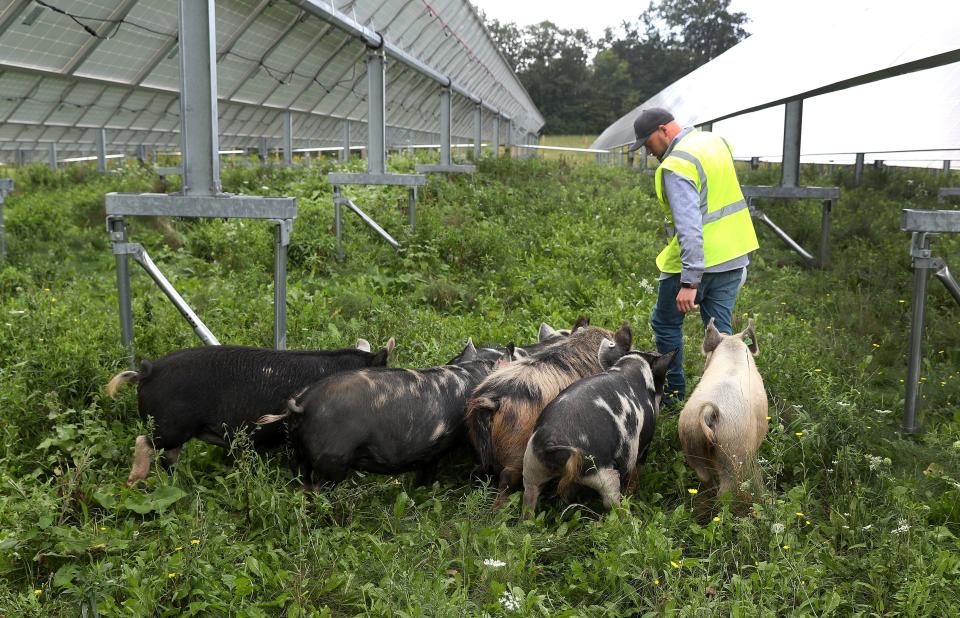
“There’s really nothing significant in the northeast,” said Lewis Fox, a Cornell grad and farmer who runs Agrivoltaic Solutions, a consulting firm that works with farmers and solar developers (he's also married to Kochendoerfer.)
“I think we won’t see any significant investment in processing until the supply is here," he said. "And so, if we can see solar grazing result in more lambs in the northeast, that’s our hope of getting some real investment and processing.”
NY officials push solar grazing, point to growth in wool industry
Upstate lawmakers whose communities have been flooded with proposals for solar farms are pushing the idea.
A bill sponsored by Democrats Anna Kelles in the Assembly and Michelle Hinchey in the Senate would create a center for Agrivoltaics Research at Cornell’s College of Agriculture and Life Sciences.
The bill’s sponsors say the idea would support food production while reducing tensions over land use issues in rural communities related to the renewable build-out. In 2022, Assemblywoman Didi Barrett, whose district includes Dutchess and Columbia counties, sponsored a measure directing the Department of Agriculture and Markets to educate farmers about the advantages of agrivoltaics.
In June, an agricultural subcommittee for the New York State Energy Research and Development Authority met to hear from Nexamp, Fox and others about ways to grow the market while promoting efficient use of agricultural land for solar development.
“NYSERDA supports education on the benefits of co-utilization for farmers, communities, and local ecologies,” a NYSERDA spokeswoman said.
Cables: NY isn't building power transmission lines fast enough, leaving energy goals in jeopardy
The group concluded that the state was “uniquely positioned” to pursue sheep grazing alongside solar energy production.
And it highlighted opportunities to grow the wool market in New York.
Australia, China and New Zealand remain the top producers of wool used for clothing and upholstery, NYSERDA’s research shows. But 75% of global fiber production comes from synthetics and man-made fiber blends.
However, demand for “eco-fibers” like wool and cotton, have grown in popularity. Valued at $40 billion in 2019, they are expected to grow to nearly $60 billion by 2025, the study shows.
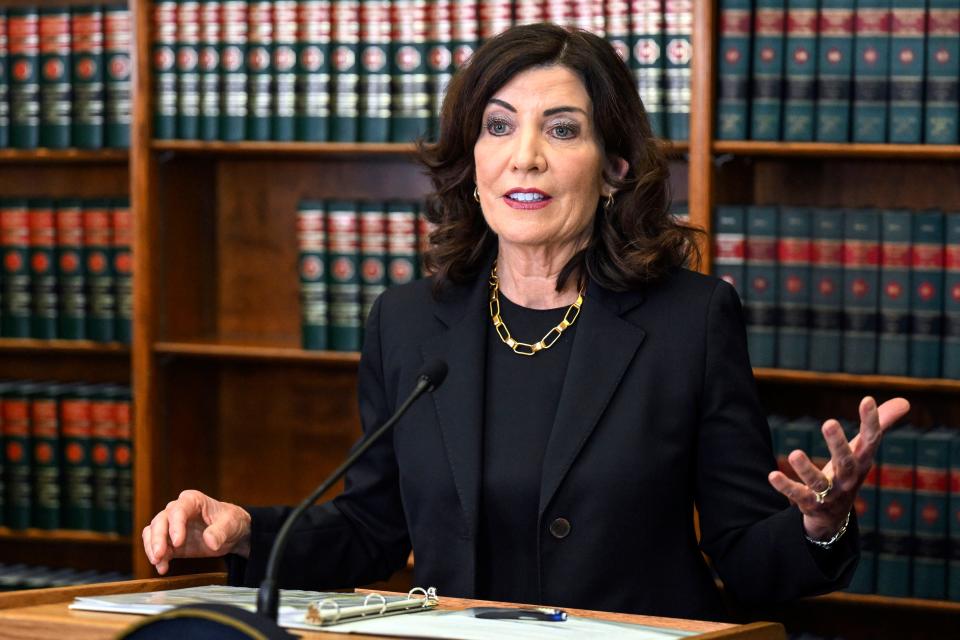
Legislation signed by Gov. Kathy Hochul in October would bolster the state’s textile manufacturing by promoting the purchase of animal and plant fiber products made in New York.
Fox’s business partner, Nick Armentrout, spent ten years working for a wool clothing company in the U.S.
“There are all kinds of hopeful signs that consumer demand is beginning to pivot,” Armentrout said. “And it’s coming back to an appreciation for farmed, land-based fibers. Not only wool, but cotton in slacks and other animal fibers too. There are hopeful signs but it’s a struggle.”
A farmer pivots from cows to sheep
Among the farmers who’ve pivoted to solar grazing is Jonathan Northrop, a third-generation farmer in Watertown, north of Syracuse.
In 2020, with the dairy market hard hit by COVID, Northrop had to make a decision on whether to stick it out or direct his energy elsewhere.
Pressure from large dairy farms has made it harder for small family farms to compete.
“The scale of operations that are required to be a profitable standalone venture is so large and the capital investment is so huge,” Northrop said.
He thought solar grazing with sheep might be a good fit for his young family, a way to involve his children in farming.
“There’s a lot more that they can do safely with them,” Northrop said. “That’s an opportunity and opportunities are few and far between in agriculture anymore.”
He started with 30 ewes purchased from farmers across the state.
Today he has nearly 500 sheep grazing on seven Nexamp sites in Jefferson County.
“As long as they continue to build enough sites to keep us busy, that’s kind of the direction we’re working with,” he said.
Solar grazing is about a third of his total revenue. So far, he’s shied away from out-of-state opportunities because it doesn’t fit his business plan.
“The sheep are our employees,” he said. “They don’t know that we’re using them to earn money. They’re just doing what they naturally do. They lay down, they chew their cud. They get up to eat again.”
This article originally appeared on Rockland/Westchester Journal News: Pigs and sheep: Could they help NY's solar build-out problem?

